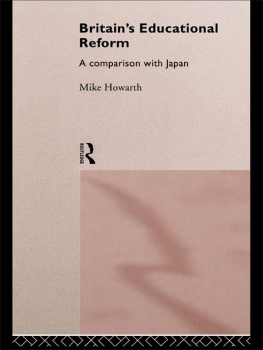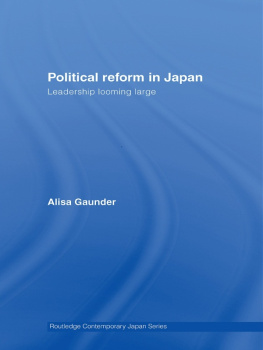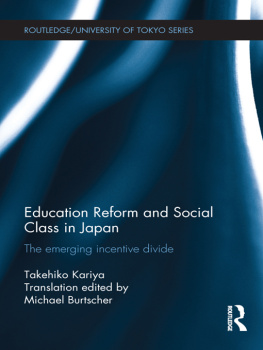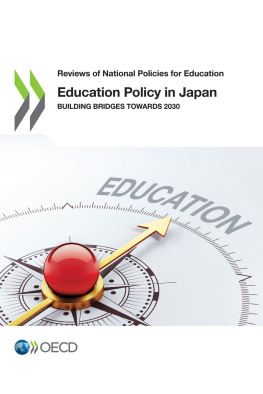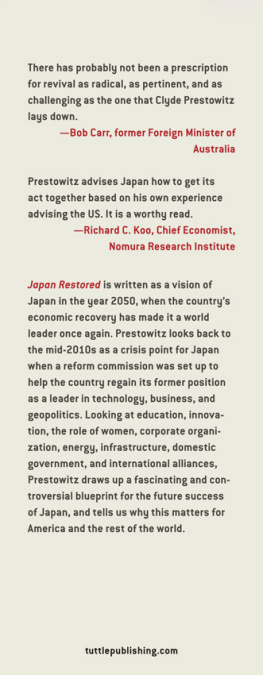Britains Educational Reform
THE NISSAN INSTITUTE/ ROUTLEDGE JAPANESE STUDIES SERIES
Editorial Board:
J.A.A.Stockwin, Nissan Professor of Modern Japanese Studies, University of Oxford and Director, Nissan Institute of Japanese Studies
Teigo Yoshida, formerly Professor of the University of Tokyo, and now Professor, The University of the Sacred Heart, Tokyo
Frank Langdon, Professor, Institute of International Relations, University of British Columbia, Canada
Alan Rix, Professor of Japanese, The University of Queensland
Junji Banno, Professor, Institute of Social Science, University of Tokyo
Titles in the series:
The Myth of Japanese Uniqueness, Peter N.Dale
The Emperors Adviser: Saionji Kinmochi and Pre-war Japanese
Politics, Lesley Connors
Understanding Japanese Society, Joy Hendry
Japanese Religions, Brian Bocking
Japan in World Politics, Reinhard Drifte
A History of Japanese Economic Thought, Tessa Morris-Suzuki
The Establishment of Constitutional Government in Japan,
Junji Banno, translated by J.A.A.Stockwin
Japans First Parliaments 18901910, R.H.P.Mason, Andrew Fraser, and Philip Mitchell
Industrial Relations in Japan: The Peripheral Workforce, Norma J.Chalmers
Banking Policy in Japan: American Efforts at Reform during theOccupation, William M.Tsutsui
Educational Reform in Contemporary Japan, Leonard Schoppa
How the Japanese Learn to Work, Ronald Dore and Mari Sako
Militarization in Contemporary Japan, Glenn Hook
Japanese Economic Development in Theory and Practice, Penny Francks
The Modernization of Written Japanese, Nanette Twine
Japanese Science Fiction, Robert Matthew
Japan and Protection, Javed Maswood
The Soil, by Nagatsuka Takashi: A Portrait of Rural Life in MeijiJapan, translated and with an introduction by Ann WaswoBiotechnology in Japan, Malcolm Brock
Britains EducationalReform
A Comparison with Japan
Mike Howarth
First published 1991
by Routledge
11 New Fetter Lane, London EC4P 4EE
This edition published in the Taylor & Francis e-Library, 2005.
To purchase your own copy of this or any of Taylor & Francis or Routledges collection of thousands of eBooks please go to www.eBookstore.tandf.co.uk.
Simultaneously published in the USA and Canada
by Routledge
29 West 35th Street, New York, NY 10001
1991 Mike Howarth
All rights reserved. No part of this book may be reprinted or reproduced or utilized in any form or by any electronic, mechanical, or other means, now known or hereafter invented, including photocopying and recording, or in any information storage or retrieval system, without permission in writing from the publishers.
British Library Cataloguing in Publication Data
Howarth, Mike, 1942
Britains educational reform: a comparison with Japan. (Nissan Institute/Routledge Japanese studies series).
1. Great Britain. Education. Reform. 2. Japan. Education. I. Title
370.941
ISBN 0-203-97578-2 Master e-book ISBN
ISBN 0-415-03850-2 (Print Edition)
Library of Congress Cataloguing in Publication Data
Howarth, Mike, 1942
Britains educational reform: a comparison with Japan/Mike Howarth.
p.cm.(The Nissan Institute/Routledge Japanese studies series)
Includes bibliographical references.
1. EducationGreat Britain. 2. EducationJapan.
3. Educational innovationsGreat BritainEvaluation.
4. Comparative education. I. Title. II. Series.
LA632.H59 1990
370.952 dc20 8971067 CIP
For Cathy and Peter
Figures and tables
FIGURES
Increase in continued education in Japan, 1950 85
Relationship between production run length, inventory costs, and economic order quantity (EOQ); (a) slow switchover (British) manufacturing (b) rapid switchover (Japanese) manufacturing
Benefits of JIT
TABLES
Fluctuation government economic bodies, 19629
Means and standard deviations in mathematics
Science achievement, 10- and 14-year olds
The 1980s international study of achievement in mathematics
Anchor question in mathematics test: British children
Mean scores on attitude to school work
Attitudes to school: science, 10- and 14-year olds
Coverage of test material in the schools
Teacher comparisons
Expenditure on pupils and education service (selected countries)
Class sizes and pupil/teacher ratios of schools
European staying-on rates
Average years of secondary education for population aged 1564 in 1950, 1973, and 1984
Secondary teachers physically assaulted or threatened in last year (A) and verbally abused in last year (B) and serious interruptions to teaching (C), (228 teachers)
Grades awarded in GCSE in selected subjects, summer 1988
Educational composition of recruits into Japanese manufacturing industry
Hensachi distribution of public-sector upper-secondary schools in Tokyo Prefecture 1983
Hensachi distribution of public-sector upper-secondary schools in Ibaraki Prefecture 1989
Curricular content and time allocated
A practical attempt to fit national curriculum and GCSE requirements into a working week of 40 periods
Allocation of curriculum hours (1) in Japanese primary schools
Credit requirements in upper-secondary general courses
Provision beyond 16-plus for pupils of an 11 18 comprehensive school
Matrix of skills required against subjects provided
Distribution of 1.44 million Japanese students between types of vocational courses in 1985
The curriculum for an electricity course
General editors preface
Almost imperceptibly, during the 1980s, Japan has become hot news. The successes of the Japanese economy and the resourcefulness of her people have long been appreciated abroad. What is new is an awareness of her increasing impact on the outside world. This tends to produce painful adjustment and uncomfortable reactions. It also often leads to stereotypes and arguments based on outdated or ill-informed ideas.
The Nissan Institute/Routledge Japanese Studies Series seeks to foster an informed and balancedbut not uncritical understanding of Japan. One aim of the series is to show the depth and variety of Japanese institutions, practices, and ideas. Another is, by using comparison, to see what lessons, positive and negative, can be drawn for other countries. There are many aspects of Japan which are little known outside that country but which deserve to be better understood.
The present book represents a new departure for the series in two senses. First of all, it is primarily a critique of the current education system and education policy in England and Wales. The record of Japanese education in producing numerate and literate pupils not only among the highly intelligent but also among those of only average ability, is carefully explored and shown to have direct relevance to the educational problems of this country. Second, the author is himself the headteacher of a large comprehensive school in South Wales, who has much direct experience, at the chalk face, of the problems he analyses in this book. He himself knows Japanese and has introduced the study of Japan into his school. The combination of his expertise in Japanese education with his position as a head-teacher within the maintained system of British education, gives a unique quality to this book.

